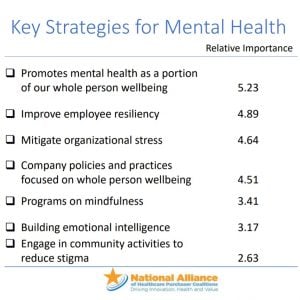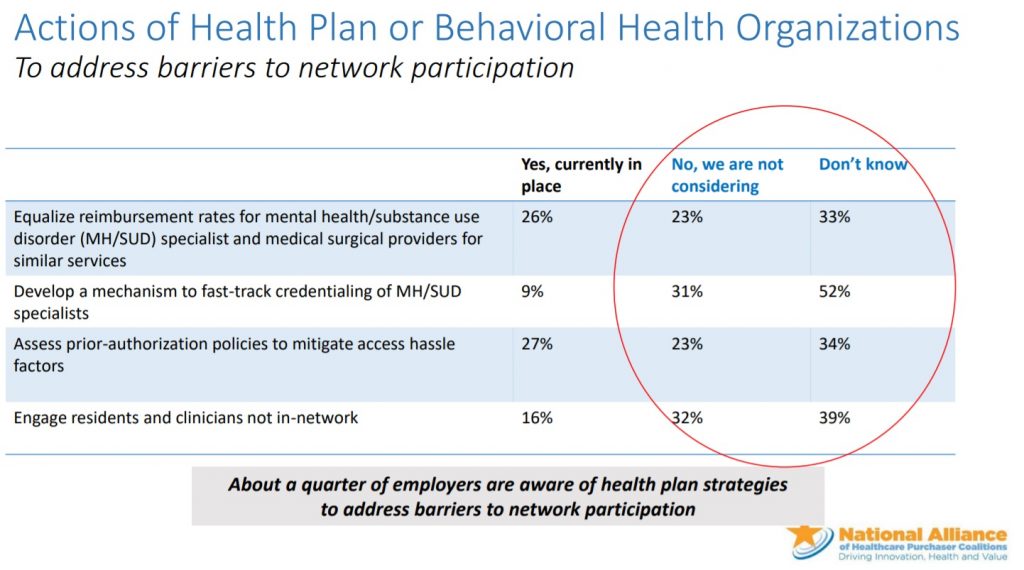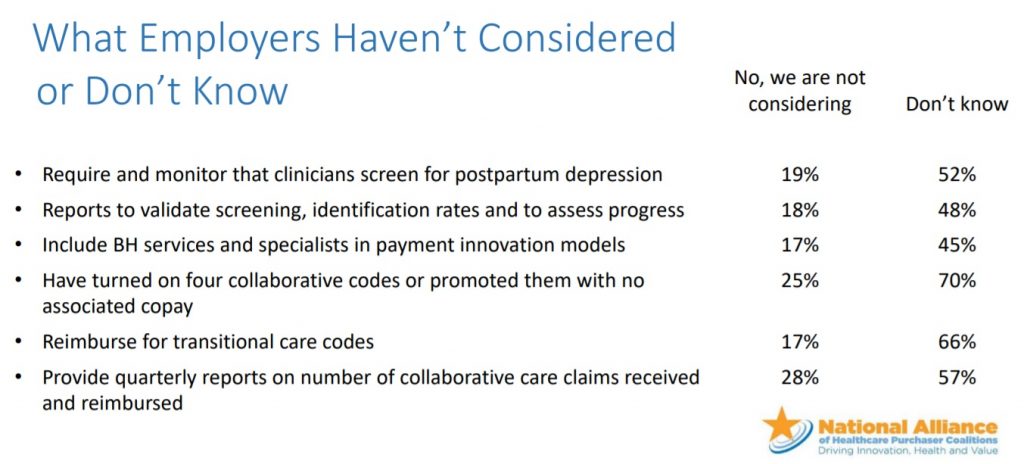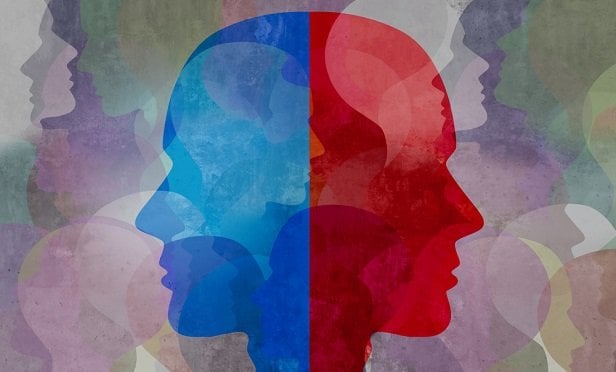 For allthe wellness initiatives and support tools employers are offering,you'd think they'd know a little more about the actual mentalhealth benefits included in their health plan. (Image:Shutterstock)
For allthe wellness initiatives and support tools employers are offering,you'd think they'd know a little more about the actual mentalhealth benefits included in their health plan. (Image:Shutterstock)
Employers are nearly unanimous in their agreement thatemployee's mental health has a direct impact on a company's performance. In fact, employerscollectively lose somewhere around $225.8 billion annually tostress, anxiety, depression, substance abuse and other mentalhealth issues.
|So why aren't they doing more to address the issue?
|In its recent 2019 National Employer Survey on Mental Health,the National Alliance of Healthcare Purchaser Coalitions took aclose look at the progress employers are making and the challengesand opportunities that lie ahead.
|Related: Breaking down the silos of mental and physicalhealth care
|The good news is that companies are waking up to the impact ofmental health on business goals and putting programs andstrategies in place to improve. The bad news is that they'reoverlooking one of the most crucial areas in need of improvement:the health plan.
|”This is a space we haven't been addressing,” LynetteHall-Lewis, health engagement senior manager for the City ofMemphis said in response to the results. “I haven't been talking tothe benefits manager on ways we can integrate.”
|“In seeing so many answers listed as 'don't know,' I get thesense of this as a people issue versus a medical plan issue,”agreed Liz Beckius, senior manager of HR rewards at Best Buy. “Whoowns which programs in the sense of well-being and wellness versusmedical plan? I don't own our medical plan, but I do own ourwellness strategy.”
|Progress in company support tools
To be sure, the HR department has been doing its part to addressemployees' mental health. Recognizing the relationship betweenmental health and employee productivity, HR has invested inwell-being programs, overhauling companyculture to wipe out stigma and countless other mental healthresources.
|Campaigns to address the stigma of mental health and change theculture around it are paying off. “There are a number of leadingorganizations that have carried on campaigns to break thatsilence,” Thompson said. “In every instance they have been verypositively received, and it has led to a higher engagement amongemployees not just in talking about these issues but in engagingwith the resources employers have in place.”
Well-being and holistic wellness programs as well are seeingsignificant investment by employers. “Many of us are familiar withemployers starting to broaden their focus around well-being,” saidMichael Thompson, president and CEO at NAHPC, listing out some ofthe new areas employers are expanding into, including emotionalintelligence and resiliency training. The latter, he says, is anarea where employers' efforts might be redirected internally.
|“There's a lot of discussion around resilience versusorganizational stress,” Thompson said. “Some research has suggestedthat as important as it is to help people cope with stress, theactual organizational demands and pressures are morepredictive.”
|Despite the early tailwinds, there is still work to be done onthe HR side: just 44 percent of employers have someone specificallyin charge of “whole person well-being;” and 41 percent offertraining on how to recognize behavioral health concerns inemployees.
|Continued focus on areas of well-being and the culture aroundmental health will not only have an ongoing impact on employeeproductivity, but it's good for the company image. “Employers endup being viewed as more caring by their employees when they takeactions like this,” Thompson said. “These issues are out there,when you break that silence, you give people permission to engageand talk about these issues, normalize this.”
|Failure to network
For all the wellness initiatives and support tools employers areoffering, you'd think they'd know a little more about the actualmental health benefits included in their health plan. But this iswhere employers are coming up short.
|Employers in NAHPC's survey knew surprisingly little about themental health coverage in their health plans, in particular, thebarriers to access care–64 percent think behavioral health accessstandards are the same for medical. “We don't see employers asactivated as they could be on these issues,” Thompson said. “Onlyone quarter employers are aware of barriers/access to networkparticipation.”
||In reality, it can oftentimes be very difficult for patients tonot only find in-network care providers, but find one that isaccepting new patients. As Thompson explained, because many mentalhealth providers can charge more (and deal with less paperwork) bytreating non-network patients, they may decline to take newpatients that are in network. “It's getting worse before it getsbetter,” Thompson said. “Mental health professionals are retiring,and new professionals are being coached not to participate innetworks.”
|So what can employers do? A lot, they just don't know it. Someof the strategies the NAHCP asked about included addressingreimbursement rates for mental health, fast-tracking credentialingspecialists and improving prior-authorization policies–areas themajority of respondents either were either not addressing or didnot know if were being addressed.
||There's also the issue of medication management. Unlike otherillnesses, medications for mental health issues aren't always anexact science. “Not all medications work for everybody,” Thompsonsaid. “You need to be sensitive to meeting the needs of individualsfor things that are labeled as the same conditions.”
|When it can take weeks or months to find the right medication tohelp a person suffering from a mental health condition (and getthem back to full productivity), there are actions employers couldbe taking to improve the process, such as genomic testing andmeasuring failure rates.
|“Measurement of care should be the standard, but it's not allthat common, nor is it required,” Thompson said. “It's an area thatI think behavioral health is behind other parts of medicine.”
|Some progress is being made, particularly in the area oftelebehavioral health: 39 percent ofrespondents are promoting such services, and 23 percent are lookingat doing so in the near future. Data coordination among vendors isbeing used by 46 percent of respondents, and half are monitoringsubstance abuse medication adherence.
|Overall, said Thompson, the results are positive. “This is abattle we're winning. The culture on mental health and well-beingis getting better every day, and one that employers are on theforefront of improving.”
|Read more:
Complete your profile to continue reading and get FREE access to BenefitsPRO, part of your ALM digital membership.
Your access to unlimited BenefitsPRO content isn’t changing.
Once you are an ALM digital member, you’ll receive:
- Critical BenefitsPRO information including cutting edge post-reform success strategies, access to educational webcasts and videos, resources from industry leaders, and informative Newsletters.
- Exclusive discounts on ALM, BenefitsPRO magazine and BenefitsPRO.com events
- Access to other award-winning ALM websites including ThinkAdvisor.com and Law.com
Already have an account? Sign In









